
In the three stage system of accidentals, a flat lowers a given tone from its natural state, and a sharp raises it. While the flat was found to be useful for tritone correction and the downward leading tone, the sharp was used to allow for more upward leading tones. The sharp may be derived from the mixture of the Dorian and Mixolydian modes. The mediant is 32/27 in Dorian, corresponding to the note F, a Minor Third above the tonic.

The Mixolydian mode differs from Dorian by one tone only; the higher mediant 81/64, the Major Third, which replaces 32/27.


Previously, Mixolydian was shown to shift the tonic to G; however, if D is maintained as the Mixolydian tonic, an alternate version of the tone normally labeled as F is found.

Although music written in Dorian employs only the note F for the third, representing the tone 32/27, in some contexts, particularly those involving G, the higher tone 81/64 may sound more suitable. Both tones are given below.

In early Western music, the note F was interpreted in two ways, either as representing the higher or lower tone, based on the context of the music. Similar to the harsh B, the higher F was said to have a sharp sound, and was called the sharp F.
| Dorian |  |
| Mixolydian |  |

The use of the sharp F for the note written as an F was part of the early practice of ficta.

The quadratum of the sharp variety came to be used to specify the higher F, which came to be known as F sharp. Like other naturals, the natural F does not normally require the natural symbol; however, in modern practice a natural note which follows a sharp note requires the natural symbol, which is said to cancel the raising effect of the preceeding sharp.
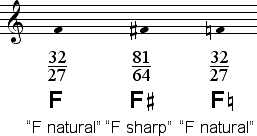
Inclusion of both versions of the note F creates a scale of eight tones, as shown below.

Mixture of the Dorian and Mixolydian modes thus results an asymmetrical system of seven naturals and one auxiliary sharp, as shown below.


The two mediants are called minor and major, corresponding to the two qualities of available thirds.
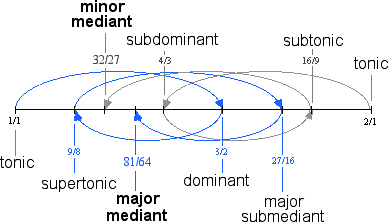

Generally, the melodic succession from F to G could utilize F
 as an upward leading tone to the G, and
F could still be used as a downward leading tone to E.
as an upward leading tone to the G, and
F could still be used as a downward leading tone to E.
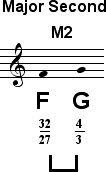
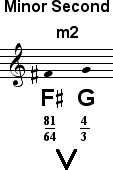
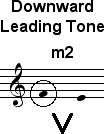
Although historically F was not typically
used for the purpose of correcting the tritone F - B, it does incidentally change the
quality of this interval from augmented to Perfect.
was not typically
used for the purpose of correcting the tritone F - B, it does incidentally change the
quality of this interval from augmented to Perfect.

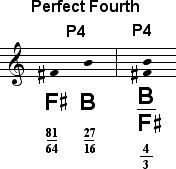
Use of both F's in Dorian allows for both the natural Minor Third and the auxiliary Major Third.

When Dorian, Aeolian and Mixolydian are mixed together, a total of nine tones results, including one sharp and one flat.


The two types of mediants and submediants are designated major and minor according to the corresponding interval qualities.

The higher mediant becomes a sharp note, and the lower submediant becomes a flat note.




Thus, our first sharp note is F ,
and our first flat note is B
,
and our first flat note is B .
.


The sharp and flat together are the beginning of the idea of accidentals:
symbols which alter naturals, making them higher, or sharper pitch, or
lower or flatter in pitch. Next, we see how the addition of B
 and F
and F results in two sizes of halfsteps.
results in two sizes of halfsteps.
NEXT: Halfsteps